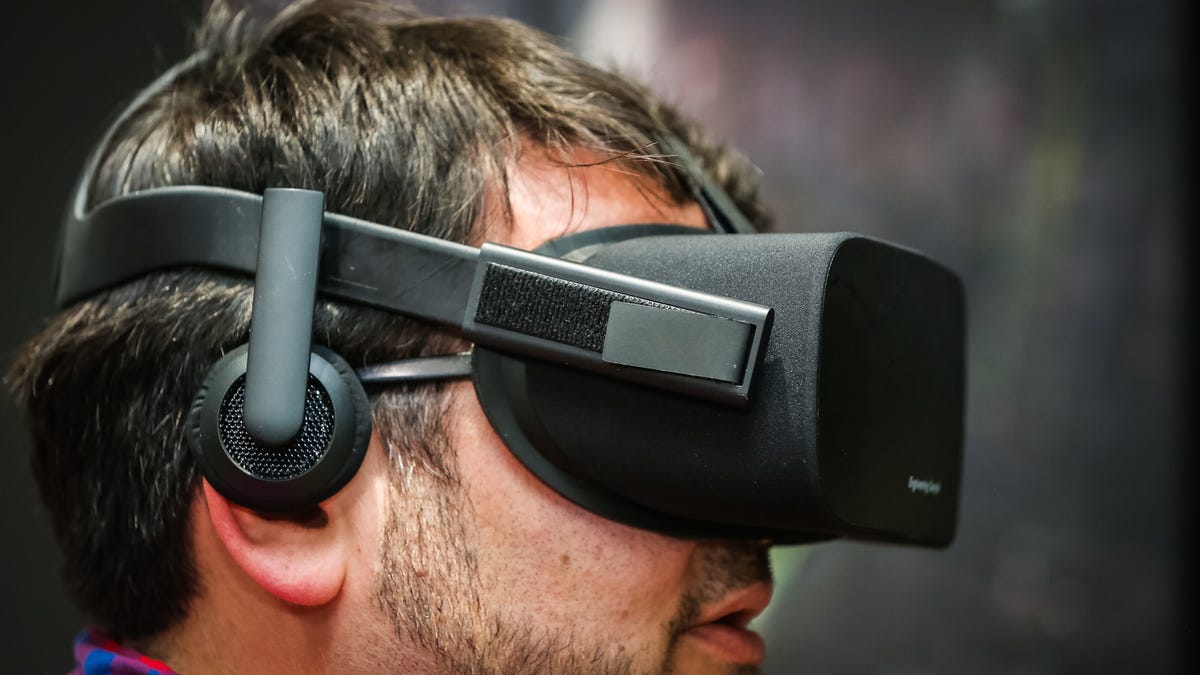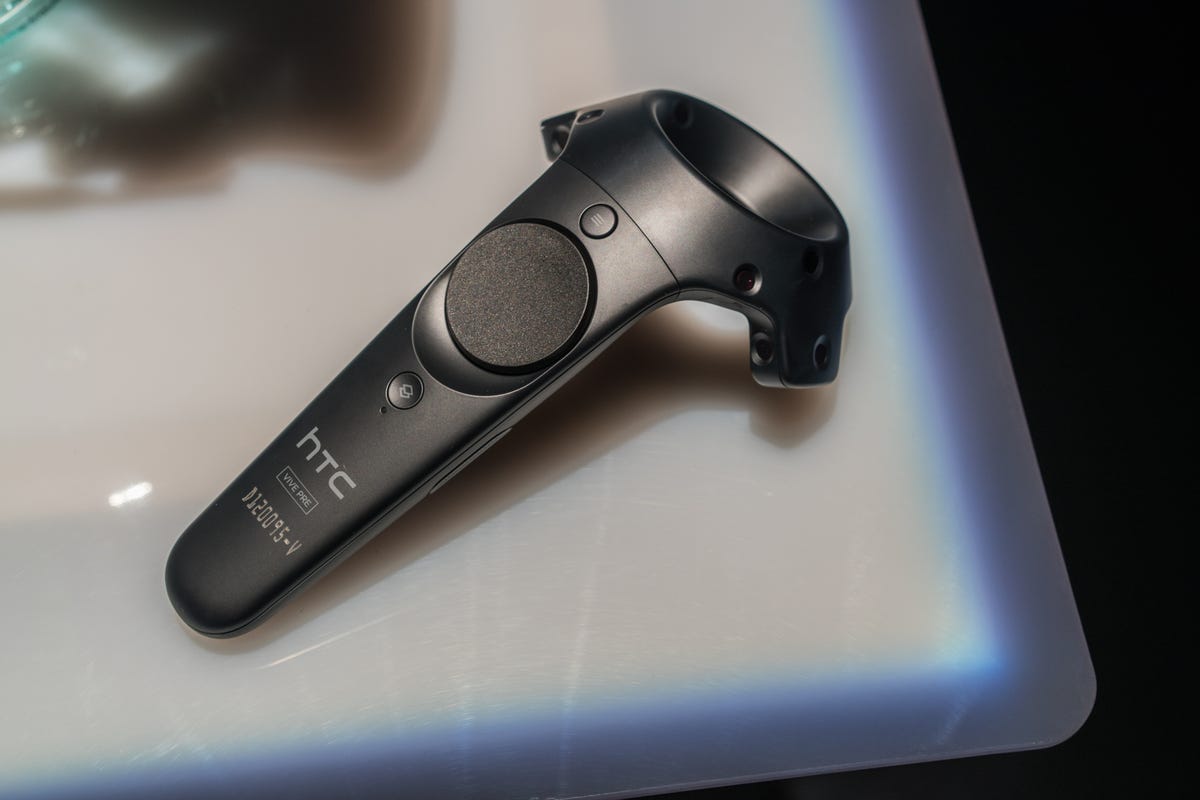The Virtual Reality Wars have begun, and it’s time to pick a side.
To our left, we have the Oculus Rift. Born of a Kickstarter project that raised $2.4 million, it’s one of the most recognizable virtual reality headsets around. We’ve watched its evolution from underdog to Facebook-backed juggernaut, and seen the promise of a platform for virtual reality evolve into something we can actually pre-order and expect in our homes this year.
To our right, there’s the HTC Vive. A comparatively recent player on the VR stage, this headset is backed by Valve, the company responsible for developing some of the most beloved PC games, and creator of the Steam digital distribution platform.


The Oculus Rift.
Josh Miller/CNET
The Oculus Rift will set you back $599, £499 or AU$649. The HTC Vive costs $799, £689 or AU$899. You’re likely going to have to make a choice between the two, so let’s run down our options.
What’s will I get?
Pre-ordering the Oculus Rift gets you the headset, and the wireless sensor that enables headtracking. You’ll also get the Oculus Remote, a little input device than will let you navigate menus and other experiences in virtual reality. And every Oculus Rift comes bundled with an Xbox One controller, making it the de facto controller for VR gaming on the Oculus — at least at launch.
Here’s what you’ll get
| Oculus Rift | HTC Vive | |
|---|---|---|
| Price | $599 / £499 / AU$649 | $799 / £689 / AU$899 |
| Bundled Controller | Xbox One gamepad, Oculus Remote | HTC Vive wireless controllers |
| Bundled Games | Lucky’s Tale, EVE: Valkyrie | Job Simluator 2050, Tilt Brush, Fantastic Contraption |
Oculus will eventually be releasing the Oculus Touch, a pair of handheld, wireless motion controllers that will be tracked by the Oculus’ sensor, and can also pick up particular hand gestures. I spent a bit of time playing with these controllers at the Oculus Connect 2 conference and, while they take a bit of getting used to, they’re a phenomenal way to interact with games in virtual reality. Unfortunately, there’s no word on when these controllers will actually arrive, or how much they’re going to cost.


The HTC Vive ships with a pair of controllers.
Nate Ralph/CNET
The HTC Vive is roughly $200 more expensive than the Oculus Rift, which necessarily raises some flags. Pre-ordering Valve’s hardware gets you the headset, a pair of wireless wands that serve as controllers and a pair of base stations (Valve calls them Lighthouses) that provide full motion tracking inside a room. You’ll also get three games: Tilt Brush, Fantastic Contraption, and Job Simulator 2050.
I’ve had a few opportunities to play those three and more on the HTC Vive, and they’re quite a bit of fun — especially when you’re playing a game expressly designed with the Vive’s wands in mind. The dedicated controllers are a nod in HTC Vive’s favor, as developers can create VR experiences with an exact idea of what their players will be working with. Using an Xbox One controller on the Oculus Rift isn’t nearly as immersive as a proper motion tracked controller, and there’s no guarantee that every Oculus Rift owner will also be picking up a Touch controller once they’re available.
What will I play?
Oculus has promised that there’ll be over 100 games available for the Oculus Rift this year, including Minecraft, Rock Band, Edge of Nowhere (by Insomniac, creators of Ratchet and Clank), and The Climb (by Crysis creators Crytek). Oculus is also producing and financing 20 games that’ll be exclusive to the platform.


The Oculus Rift is bundled with an Xbox One controller.
Oculus
Valve hasn’t promised a huge slate of titles for the HTC Vive just yet, but you can find some of the games that are coming here on Valve’s Steam store. A number of games will also be available on multiplatforms — I’ve played Job Simulator on both the Oculus Rift and the HTC Vive, and it’ll be headed to PlayStation VR, too. It’s likely a bit premature to pick a VR platform based on the games that might be available, but Oculus arguably has a lead here.
What will I need to get started?
Fortunately, we have a pretty clear idea of what’s required to get started with both the HTC Vive and the Oculus Rift. Here are the recommended system requirements for both platforms.
VR-ready system recommendations
| Oculus Rift | HTC Vive | |
|---|---|---|
| CPU | Intel i5-4590 or equivalent | Intel i5-4590, AMD FX-8350 or equivalent |
| Graphics | Nvidia GTX 970, AMD R9 290 | Nvidia GTX 970, AMD R9 290 |
| Memory | 8GB+ | 4GB+ |
| Video output | HDMI 1.3 | HDMI 1.4 or DisplayPort 1.2 |
| USB ports | 3x USB 3.0, 1x USB 2.0 | 1x USB 2.0 |
| Operating system | Windows 7 SP1 or newer | Windows 7 SP1 or newer |
As you’ve probably noticed they’re nigh identical, which makes things decidedly easier if you’re looking to build or buy a new VR-ready PC sometime in the next few months. You can also use Valve’s SteamVR Performance Test or the Oculus Rift compatiblity tool to see if your current hardware is up to snuff.
Which should I choose?
It’s a close call. I’m completely smitten by the HTC Vive’s wands, as the games I’ve played (including plenty of mini golf) have shown what’s possible when a developer creates an experience specifically for a controller. The Oculus Rift will be reliant on the Xbox One controller until the Oculus Touch arrives, which necessarily changes how we’ll interact with the games on the system. That being said, these are both primarily gaming platforms, and the Oculus Rift will have 100 different games to try by the end of the year. It’ll also be able to stream games from your Xbox One, if you’re keen on sitting in a virtual living room.


Hands-on with the Oculus Touch.
Juan Garzón/CNET
The Vive’s room scale virtual reality promises unprecedented immersion, and the headset does clever things, like letting you know when you’re about to walk into a wall, and a camera on the front that’ll give you a look at the room around you. But the Oculus Rift offers headtracking too, care of infrared LEDs studded around the headset, and will save you about $200. Either way, I suspect you won’t be too disappointed: virtual reality is here, and it’s awesome.
What are my other options?
We’ve focused on the the two VR platforms coming for the PC, but if you’re not a PC gamer or don’t want to shell out the cash to build yourself a gaming rig, you’ve got a few more options. I remain a fan of Google Cardboard, a cheap and cheeky take on virtual reality, powered by your mobile phone. Samsung’s Gear VR is a far more robust option, though it’s limited to newer Samsung phones, like the Samsung Galaxy S6, S6 Edge, S6 Edge+, Note 5 or the upcoming Galaxy S7 or S7 Edge. LG’s 360 VR is yet another mobile VR option, and was announced at Mobile World Congress. It’ll connect to the LG G5 by way of a USB-C cable, which adds a cable into the mix, but the glasses are small, and weighs far less than the competition.
If you’re a console gamer, Sony’s got you covered with PlayStation VR. The VR experiences we’ve seen on PlayStation VR haven’t been as crisp or or life-like as the ones we’ve tried on the HTC Vive or Oculus Rift, but a beefy gaming rig will cost you a bit more than a $350 PlayStation 4. There’s still no word on a price or a release date, however.



